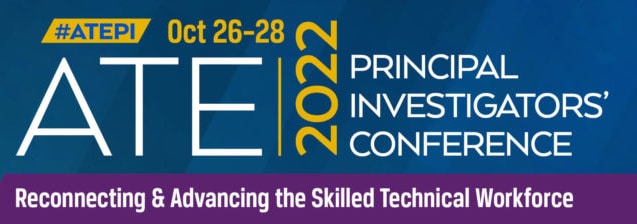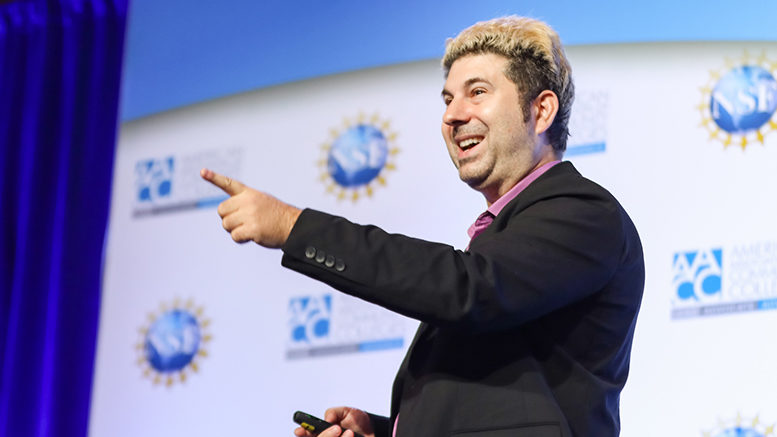Educators can better help students realize their full potential if they look beyond IQ and other standard measures of intelligence and consider their current level of competence, life skills, passion and inspiration to succeed, the keynote speaker of the 2022 Advanced Technological Education (ATE) Principal Investigators’ Conference said Wednesday.

“I don’t want you to get too stuck on your students’ SAT scores or maybe prior markers of success, but really…look at what they are actually accomplishing,” cognitive scientist and humanistic psychologist Scott Barry Kaufman said at the opening of the three-day conference in Washington, D.C. The American Association of Community Colleges (AACC) hosts the event in partnership and with the support of the National Science Foundation (NSF).
Personal experience
The founder of the Center for the Science of Human Potential, Kaufman developed a theory of intelligence that looks at the “interplay of engagement and ability in pursuit of personal goals.” Students placed in a high expectation environment, he said, will move toward becoming their “best self.”
Kaufman learned this at an early age.
Diagnosed with a central auditory processing disorder as a result of childhood ear infections, Kaufman said he was kept in special education classes until ninth grade. “People didn’t think I was very smart,” he said. Then a teacher took him aside and asked, “What are you doing here?” This conversation led to him being transferred into mainstream courses in which he performed well.
Kaufman discussed tools to unlock student creativity, innovation and self-actualization as well as strategies to build resilience to help create a “human-centered skilled technical workforce.”
He proposed a learning model based on competence, commitment and creativity that takes into account a wide variety of experiences and behaviors. They range from having a cognitively stimulating home environment, appreciation for beauty, active imagination, perseverance and healthy self-esteem to being inspired and hopeful. He advised educators not to neglect these factors when predicting student success.
“Some of us say, ‘Oh, that kid is not talented,’ If they (students) have the inspiration, if they have the harmonious passion, give them the resources – but especially if they have the inspiration because, over the long run, that is going to lead to greater dividends… than if they just have the talent and they don’t have those other things,” he said.
Back in person
Conference participants included hundreds of two-year college faculty who are the principal investigators or team members of Advanced Technological Education projects and centers funded with grants from NSF, industry partners of ATE projects and centers, and 42 students. This first in-person ATE Conference since 2019 is augmented by virtual sessions last week and next week for ATE grantees and their teams. Both the in-person and virtual conference feature sessions on such topics as recruiting and retaining students in advanced manufacturing, biotechnology, cybersecurity, nanotechnology and robotics.
The ATE program is NSF largest investment in associate-degree-granting institutions. Its 350 active awards range from about a hundred thousand to several million dollars. NSF anticipates it will award $75 million during fiscal 2022 for educators to test their innovative ideas to improve the preparation of the skilled technical workforce. ATE Central is database that facilitates public access to the model curricula, professional development programs, STEM outreach initiatives, career pathways, research and other resources created by ATE grantees.
The ATE program offers mentoring to help two-year-college teams prepare proposals. October 5, 2023, is the next ATE grant proposal deadline. For more information see the program solicitation.
NSF support
“ATE is an amazing program,” said Rosalyn Hobson Hargraves, division director of the NSF’s Division of Undergraduate Education. “The way you are able to bring together innovation, partner with industry, partner with your administrators, partner with your communities to really prepare the next generation of our skilled technical workforce is vitally important.”
Hargraves also commended ATE for embodying the principles of “equity, access, innovation and excellence” in education.
V. Celeste Carter, who is the lead program director of ATE at NSF, said ATE is “truly a community of like-minded individuals who really work hard to stay at the cutting-edge of emerging technologies, support our students, think about engaging pedagogical strategies in the classroom [and] work with industry.”

